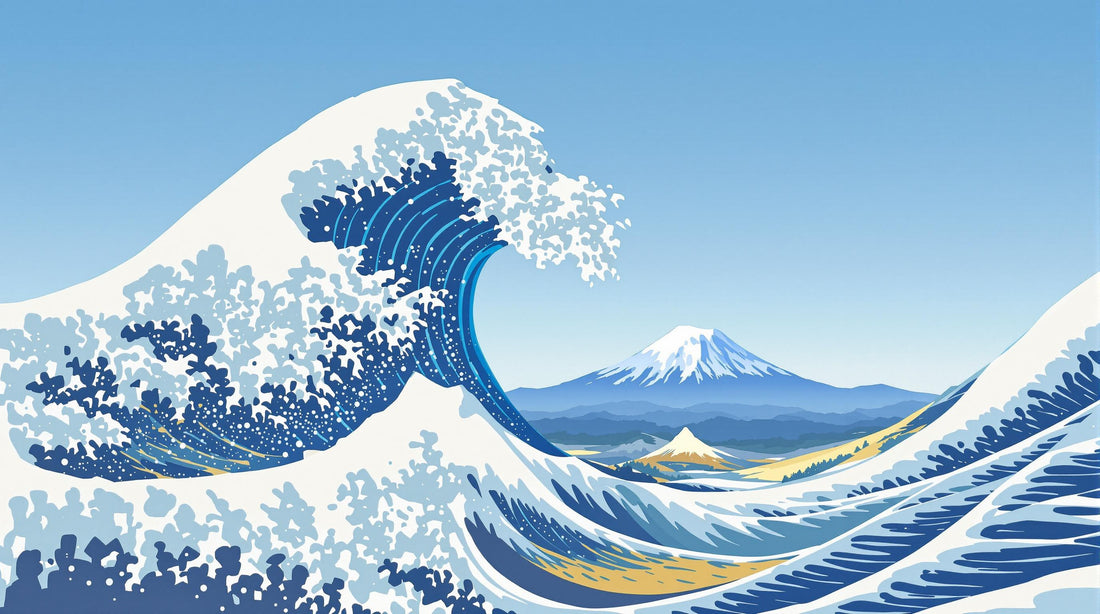
Great Wave Off Kanagawa: Hokusai’s Hidden Story
Share
'The Great Wave Off Kanagawa' by Katsushika Hokusai is one of the most famous artworks in history, created in 1831 during Japan's Edo period. Here's why it matters:
- Artistic Significance: It’s the first print in Hokusai’s series Thirty-six Views of Mount Fuji, showcasing innovative techniques like Prussian blue pigment (imported from Europe) and dynamic composition.
- Symbolism: The towering wave symbolizes nature’s power and Japan’s isolationist policies, while Mount Fuji represents spiritual endurance.
- Global Influence: Inspired Western artists like Claude Debussy and Vincent van Gogh, and played a role in the Japonisme movement in Europe.
- Rarity: Only about 100 original prints survive today, making it both iconic and rare.
- Cultural Impact: Featured in modern media, design, and even on Japanese currency in 2024.
This woodblock print blends Japanese tradition with global influences, reflecting themes of resilience, nature, and cultural exchange. Its legacy continues to inspire art and design worldwide.
Hokusai's Life and Art
Hokusai's Life: Challenges and Achievements
Katsushika Hokusai, born in 1760 in Edo (now Tokyo), overcame a life filled with hardship to become one of Japan's most celebrated artists. Despite enduring relentless poverty, Hokusai began his artistic journey at an early age [2].
He reshaped Japanese art through his evolving style. Initially focusing on typical subjects like actors and courtesans, he gradually explored themes like samurai legends and Chinese-inspired motifs. This relentless drive for artistic growth eventually led to his masterpiece, The Great Wave, part of the iconic Thirty-six Views of Mount Fuji series [2].
Vincent van Gogh once described Hokusai's waves as "terrifying with blue and green... these waves are claws, the boat is caught in them", emphasizing the emotional intensity of his creations.
Influences on 'The Great Wave'
The creation of The Great Wave was shaped by a mix of cultural, historical, and personal factors. During Japan's Edo period of isolation, Hokusai introduced bold new techniques that pushed artistic boundaries. One standout feature was his use of Prussian blue, a pigment introduced to Japan earlier, which gave the wave its vivid color.
Several key influences shaped the print:
| Influence | Impact |
|---|---|
| Cultural | Inspired new techniques during Japan's isolation |
| Artistic | Borrowed dramatic seascape elements from Dutch maritime art |
| Personal | Reflected Hokusai's deep connection to nature and life's fleeting nature [4] |
Hokusai's work embraced the essence of ukiyo-e while challenging its limits with inventive perspective and composition [2][3]. The tension between the towering wave and the distant, serene Mount Fuji showcases both his technical brilliance and his philosophical insight [3][4].
Today, only 100 original prints of The Great Wave are known to exist. Art historians believe Hokusai's imaginative perspective helped shape global art movements, with one noting, "Without Hokusai's sense of imagined perspective, Impressionism would probably have taken a different route."
This blend of influences resulted in The Great Wave, a piece that transformed artistic expression and symbolism. Let's dive deeper into its significance.
Analyzing 'The Great Wave': Techniques and Meanings
Techniques Used in 'The Great Wave'
Hokusai's use of Prussian blue, a pigment newly introduced to Japan at the time, gives the wave its bold and striking color. His dramatic perspective - placing the towering wave above the small Mount Fuji - emphasizes the overwhelming power of nature and creates a dynamic sense of motion [3].
The woodblock printing technique showcases an impressive level of detail in the wave's design. Key technical elements include:
| Technical Element | Artistic Effect |
|---|---|
| Perspective | Creates tension and depth |
| Prussian Blue | Brings richness and intensity |
| Line Work | Enhances the wave's intricate details |
| Scale | Highlights the vast power of nature |
Symbols and Hidden Details in 'The Great Wave'
Beyond its technical mastery, 'The Great Wave' is rich in symbolism, reflecting Japan's cultural and historical backdrop during the Edo period. The fishing boats, for instance, are thought to symbolize humanity's struggle and resilience in the face of nature's formidable power [4].
Interestingly, the wave's white caps are not typical of a tsunami but instead represent the complex and ever-changing relationship between humans and nature [3]. Mount Fuji, small yet prominent in the background, holds deep spiritual significance as a sacred symbol of Japan's identity [3][4].
Art historian James Payne has interpreted the piece as a reflection of Japan's vulnerability during its era of isolation. The threatening wave may represent external forces, while the fishing boats highlight the resilience and determination of the Japanese people [1].
Some of the key symbols and their interpretations include:
| Symbol | Meaning |
|---|---|
| Wave | Represents nature's unpredictability and Japan's isolation |
| Mount Fuji | A symbol of spiritual endurance |
| Boats | Illustrate human perseverance |
| Composition | Reflects the 'floating world' concept in ukiyo-e art |
Hokusai's ability to combine technical precision with layered symbolism makes 'The Great Wave' a timeless work that continues to captivate and inspire. These elements not only define the artwork but also underline its place within the larger ukiyo-e tradition, which we will delve into next [4].
Ukiyo-e Art and 'The Great Wave'
Understanding Ukiyo-e
Ukiyo-e, which translates to "pictures of the floating world", emerged during Japan's Edo period (1603-1868) as a distinct art form. Initially focused on the fleeting nature of life, it later evolved to reflect the vibrant urban culture of the time [7]. This art form was created through a collaborative effort involving artists, carvers, printers, and publishers, which enabled mass production and made art more accessible to the growing merchant class.
"Ukiyo-e is unique as a Japanese art form. Unlike other Japanese products like a sword or piece of pottery, which may be the work of primarily one master artist, Japanese woodblock prints rely on multiple industries and skills to create a finished product." - Sakuraco [7]
The collaborative production process allowed ukiyo-e prints to reach a wide audience, fundamentally changing how art was experienced and appreciated in Edo-period Japan [6].
Hokusai's Contributions to Ukiyo-e
Katsushika Hokusai transformed ukiyo-e by shifting its focus from traditional portraiture to dynamic landscapes. Over his career, he created nearly 3,000 color prints, 1,000 paintings, and more than 200 illustrated books [4]. His series "Thirty-six Views of Mount Fuji" (1830-1833) stands out as a defining achievement, with "The Great Wave off Kanagawa" becoming its most iconic piece [4][6].
Hokusai introduced groundbreaking changes to ukiyo-e, including:
| Innovation | Impact |
|---|---|
| Dynamic Compositions | Brought a new level of visual drama |
| Landscape Focus | Elevated nature scenes to a central artistic theme |
| Technical Precision | Improved woodblock printing techniques |
His use of the bokashi technique, which creates smooth color gradations, added a new level of depth and detail to woodblock prints [4][6]. These advancements, paired with his artistic vision, expanded the possibilities of the medium.
Hokusai's work not only redefined ukiyo-e but also set the stage for 'The Great Wave' to become a global cultural icon, influencing artists far beyond Japan.
sbb-itb-e829fd7
The Lasting Impact of 'The Great Wave'
Influence on Western Artists
'The Great Wave off Kanagawa' played a key role in the Japonisme movement, which reshaped Western art in the late 19th century. Van Gogh once described the wave as "terrifying with blue and green... claws, the boat is caught in them", capturing its raw emotional power [6].
Hokusai's work served as a bridge between Japanese and Western artistic traditions. Here are a few examples of its influence:
| Artist | Influence |
|---|---|
| Claude Debussy | Used 'The Great Wave' on the cover of La Mer (1905) [5] |
| Henri Rivière | Paid homage with Thirty-Six Views of the Eiffel Tower (1902) [5] |
| Lin Onus | Reimagined it in "Michael and I are just slipping down to the pub for a minute" (1992) [5] |
'The Great Wave' in Modern Media
Hokusai's masterpiece continues to resonate far beyond traditional art. In 2024, the Japanese government featured the iconic image on a new banknote, reinforcing its role as a symbol of national identity [5].
The artwork's influence extends into modern design and culture. It has become a cornerstone in Japanese art education worldwide, inspiring fields like architecture and fashion. This blend of traditional and modern styles ensures its relevance across generations.
"The Great Wave off Kanagawa blends Japanese tradition with European perspective" [5]. This universal appeal has made it a cultural touchstone across the globe.
From tattoos to digital media, 'The Great Wave' remains a powerful symbol of the connection between humanity and nature. Its ability to adapt to contemporary contexts while preserving its emotional depth has made it one of the most reproduced images in Japanese art history [6][5].
Hokusai's masterpiece continues to teach us about the balance between preserving tradition and embracing new ideas, leaving an enduring mark on art and culture.
The Great Wave by Hokusai: Great Art Explained

Conclusion: The Hidden Story of 'The Great Wave'
'The Great Wave off Kanagawa' is more than just a famous artwork; it's a reflection of the dynamic mix of tradition and change during Japan's Edo period. Created in 1831, this woodblock print emerged during Japan's era of isolation but managed to connect Eastern and Western artistic worlds in unexpected ways.
Hokusai's work reflects his perspective, shaped by Japan's selective engagement with outside influences during its isolationist policies. His techniques show a respect for traditional ukiyo-e craftsmanship while introducing new methods [1]. The striking contrast between the towering wave and the serene Mount Fuji captures themes of harmony and tension that resonated deeply in Edo-period Japan [3].
Lessons from 'The Great Wave'
From its design to its global impact, 'The Great Wave' offers enduring insights about art and cultural exchange. Art historian James Payne points out that the print's composition broke artistic norms of its time [1]. Its journey from a local creation to a worldwide symbol illustrates how art can communicate across cultures and eras.
The legacy of 'The Great Wave' highlights the importance of blending tradition with fresh ideas, encouraging cultural exchange, and addressing themes that feel universal. Its influence stretches across centuries, inspiring creators from different fields and cultures [4].
Hokusai's work reminds us of the power of persistence, creativity, and the ability of art to connect people. It’s not just a historical artifact - it’s a living example of how art can cross boundaries and inspire new generations. 'The Great Wave' continues to prove that creative expression has the power to transcend time and speak to audiences everywhere.
FAQs
What inspired Hokusai's artwork?
Hokusai drew inspiration from a variety of sources during Japan's Edo period. His early work shows a clear influence from traditional Chinese painting, particularly the techniques of Sesshū Tōyō. At the same time, Japan's isolationist policies and growing awareness of foreign industrial advancements shaped his artistic direction [1][2].
Hokusai's work is a mix of classic Japanese motifs and inventive artistic methods. This combination reflects both his formal training and his drive to explore new creative approaches within the ukiyo-e tradition, producing art that continues to resonate globally [4].
What artists were inspired by The Great Wave off Kanagawa?
The Great Wave has had a lasting impact on artists in both Eastern and Western traditions. Vincent van Gogh, for instance, admired its emotional power, describing the waves as "terrifying" and "claw-like" [6].
Western artists such as Claude Debussy and Claude Monet found inspiration in Hokusai's masterpiece. Meanwhile, in Japan, artists like Hiroshige and Kuniyoshi - Hokusai's younger contemporaries - created their own wave-themed works, building on the ukiyo-e tradition while exploring fresh artistic directions [4].
Beyond fine arts, The Great Wave has influenced modern media, fashion, and design [3][4]. Its ability to connect cultures and inspire creativity across generations highlights its enduring legacy.
